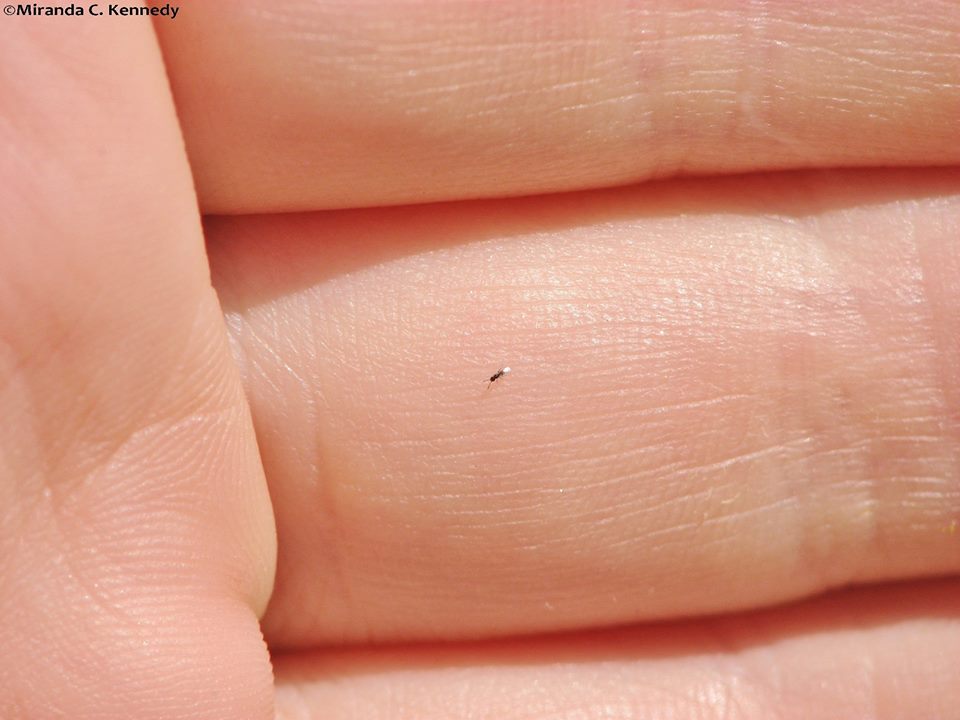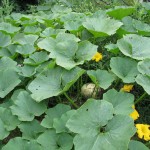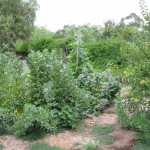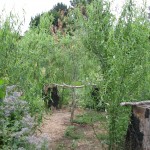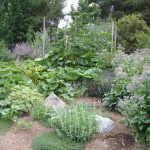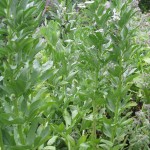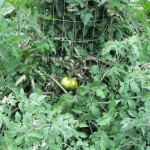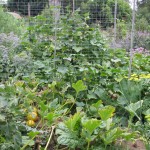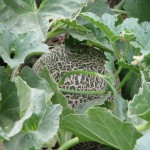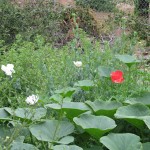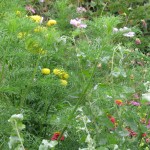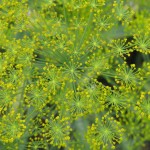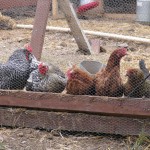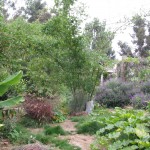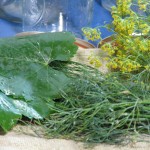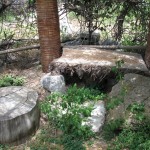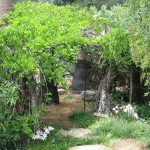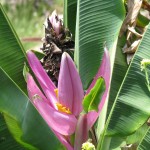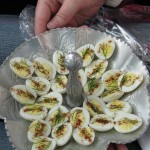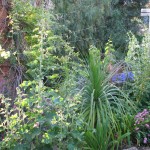-
Delicious and Fun Thai Custard-inna-Pumpkin

Thai Custard-inna-Pumpkin I know that you lose sleep over trying to figure out how to get more vegetables into your dessert. Well, snuggle up for a good long snooze, because here’s a recipe to bring you peace! I found this recipe in the Heirloom Gardener Winter 2012- 2013 edition. The magazine is created by the people who bring you Baker Creek Heirloom Seeds (organic). A wonderful article about Thai cooking by Wendy Kiang-Spray features this intriguing recipe, and I had to try it. You hollow out a small Thai or Kabocha squash (they are drier in texture), fill it with a coconut milk custard, steam it, and Bob’s your uncle!

Scoop out the seeds and fibers and feed them to your chickens! I just happened to have a 2.5 lb homegrown Kabocha squash handy, so I made the recipe (adding a little cinnamon). Not wanting to be scared alone, I brought the whole cooled squash over to my friend Lara’s house, who helping me fulfill last year’s New Years resolution by teaching me basic piano. Being a vegetarian and a loyal friend, she was game to try it. It came out very good. I was impressed. I will do this again!
Troubleshooting: whisk the ingredients together. I thought I’d be fancy and put them into my VitaMix on the lowest setting, but even that added a little too much air to the custard mixture.
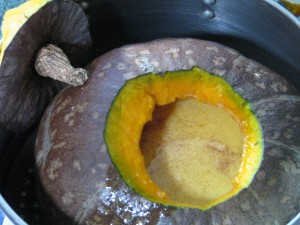
Don’t fill all the way up. Steam the lid off to the side. The top of the custard that I could see was yellowish, and I figured that this was due to the dark yolk in the eggs from my chickens, but I don’t know. Once cut into, though, the custard as a lovely white.
I turned my steamer on high until it was boiling, then turned the temperature down low and the custard wasn’t done in the allotted time. Next time I’ll keep it at a higher boil so that the steam is hotter. I cooked it much longer (I think too long because I was doing other things) and the squash split a little as it was very soft. I kept it in the steamer with something between the soft side and the inside of the steamer so that the squash would keep its shape as it cooled. After it was room temperature, I put it in the refrigerator for a short time and it the squash didn’t fall apart when I removed it.
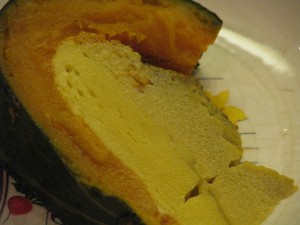
Creamy coconut custard and dry delicious squash. Ms. Kiang-Spray states in her article that this recipe is known in Thailand as Sankaya and is a classic dessert. With all the eggs and tasty squash, I’d call this breakfast or lunch, too!
Thai Custard-inna-PumpkinAuthor: Diane C. Kennedy (adapted from recipe by Wendy Kiang-Spray)Recipe type: DessertCuisine: ThaiPrep time:Cook time:Total time:Serves: 6A simple, fun, lovely dessert that people will remember as they get their beta carotene.Ingredients- 1 2 -3 pound dry-fleshed squash such as Kabocha or Thai pumpkin.
- ¾ cup coconut milk
- 5 eggs (preferably at room temperature)
- ⅓ cup sugar
- Pinch of salt
- 1 teaspoon vanilla extract
- ¼ teaspoon cinnamon
Instructions- Bring two quarts of water to a boil in the bottom half of a steamer pot.
- Use a cup to trace a circle around the top of the pumpkin.
- Cut the lid off around the guideline.
- Hollow out the inside with a spoon, making sure to get all the fibers.
- In a bowl gently whisk until combined the rest of the ingredients.
- Place the squash into the steamer basket.
- Pour custard through a sieve into the pumpkin leaving an inch to the top (filling will rise).
- Include the squash lid next to, but not on top of, the squash.
- Steam covered and undisturbed for 55 minutes until a knife inserted into the custard comes out clean.
- Remove steamer basket from over heat and allow squash to come to room temperature.
- Slice into wedges (in front of admiring company!) and serve.
- Serve at room temperature or chilled.
- Compost, Gardening adventures, Hugelkultur, Permaculture and Edible Forest Gardening Adventures, Soil, Vegetables, Worms
Lazy Composting
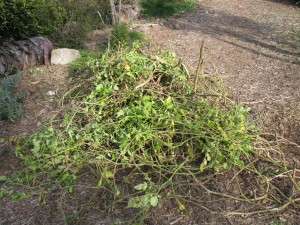
Tomato vines… what to do? I have a Rubbermaid compost bin where I dump my kitchen scraps, and a nifty three-bin pallet compost bin for larger stuff, as well as wire cages where I’ve heaped tough weeds and vines.

My wire bins floweth over. All of these methods of composting are great. They also require some physical work that I’m wary of these days. I still keep my old raised veggie beds lined with chicken wire and use them for controlled or experimental crops and extra seed. The soil in them settles after awhile and because I don’t turn my compost heaps enough I don’t produce enough compost to haul over and refill the beds.

Soil is at a low level in the raised beds. Today I decided to try mini hugelkultur beds. Hugelkultur is the practice of heaping wood and other organic matter, covering it with soil and planting directly on the pile. The berm catches water and the buried wood holds the moisture, releasing it slowly to the plants and gradually decomposing to create beautiful soil. When I planted my strawberry bed two years ago I buried old lime tree logs all along the edge. Now that soil is beautiful as the logs decompose, helping to acidify the soil for the acid-loving strawberries, and holding moisture by the roots. Some strawberry plants have rooted right in the logs.

Strawberries have rooted runners directly into the rotting lime logs. The soil around the logs is perfect. In one of my long raised veggie beds I cleaned out the frosted tomato vines and what sweet potato vines were left after our harvest.

Frosted tomato vines: treasure, not trash! I don’t like to disturb the soil because that kills microbes, fungus and worms, but this soil hadn’t been perfect to begin with.
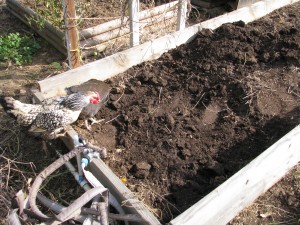
Digging up the soil and trying to protect the worms from the persistant chickens. I shoveled out a portion of the soil then cut up the tomato vines and dropped them in the bed.
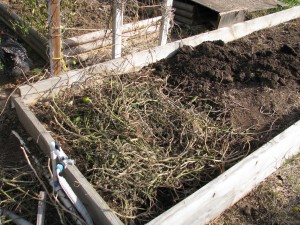
Heaping on the vines. Then I shovelled the dirt back over again, and made my way down the bed until all the vines had been covered.

A few vine ends stick up, but that’s okay. If I had more soil I’d bury them more. I also sprinkled on sugar and epsom salts, to feed the microbes and add magnesium (I’ll blog about these two garden wonders another time).
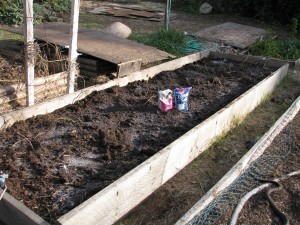
Magnesium-rich epsom salts and sugar (organic molassas is better) invigorate the soil. Burying garden leftovers like this does several things. It quickly feeds the microbes and worms in the soil without the critters having to gnaw on them from underneath or wait until the plants decompose more. The vines keep the soil from compacting and help hold moisture when it rains.

I cut the tomato vines and leave the stem and roots. Worms love roots. The vines had taken nutrients up into the leaves and fruit, and now many of those same nutrients are being returned to the bed in which they grew. Keeping the soil moist from underneath is a valuable way to protect seedlings from bugs. Top mulch I have found to be a nursery for damaging pill bugs, which you might call ‘rolly-pollies’ or sow bugs.
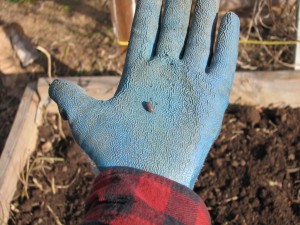
A sow bug on my glove (No, I’m not a Smurf). Although experts say that sow bugs don’t directly damage plants and fruit but rather feed off of already damaged produce, I have my doubts. If so, I believe that mine hired another bug or bird to damage about half of my strawberry crop last year so that they could feast on them.
Because decomposing green matter will initially take nitrogen from the soil, I’ll let this bed sit for a couple of months before planting, or if I can’t stand to wait I’ll plant nitrogen-fixing peas as a cover crop. I won’t repeat the same crops in this bed because it is smart to rotate families of veggies for many reasons, including pest control. Whatever I put in here, however, will be a mix of seeds.

I spy a sweet potato that hid the harvest by growing under through the wire and under the board! Another bed I’ve been playing with had been empty and needed soil. Over the last season I’ve thrown in garden debris and a layer of llama poo topped with sweet potato vines. Last week I balanced a piece of plywood over it. Today I took a peek and the vines are covered with bugs decomposing in the moist darkness of the plywood as the heap gradually settles. I’ll leave it be and keep checking on its progress.

Plywood balanced on piled garden debris I have more lazy composting ideas for the entire property. I’ll let you know.
- Compost, Gardening adventures, Giving, Health, Natives, Permaculture and Edible Forest Gardening Adventures, Soil, Vegetables
Stinging Nettle and World Peace
One of my very good friends asked me what to do about a proliferation of stinging nettle in her yard. There is a creek running through the bottom of her property, and while once there had been Jimson weed and other natives growing there, now there is just nettle which is spreading to her lawn. Her hand hurt for a day from inadvertently pulling some out bare-handed. Her neighbor had told her that “nettle was bad” and would take over. She was laying cardboard on some of it, but was afraid that wouldn’t be enough.
One of the main practices of permaculture is to take what is considered to be a problem and look at all sides of it, just as in Zen you must think like your enemy, or in some Native American beliefs you must walk a mile in another’s shoes.
Fortunately I knew some things about nettle, and told her that nettle was not only edible once the acid had been blanched away, but highly nutritious. Here is a good description of what it can do. It is a superb compost enervator. The disappearance of the other natives by the streambed was evidence that someone upstream had sprayed an herbicide that washed downstream and killed everything. The prolific growth of stinging nettle, which is an indicator plant for high nitrogen in the soil, showed that someone’s high nitrogen lawn fertilizer came the same way.
Nettle’s acid is simply an excretion by the plant on the hairs along its stem to discourage browsing animals. The sting is immediate and temporary, unlike poison oak which has an irritating oil that can spread with touch and takes a few days to cause a rash. In nature often the cure grows near the problem, and therefore both the riparian plants mint and plantain can be rubbed onto the area to alliviate the sting, but soap and hot water works just as well. Nettle reproduces only by seed, not by rhizomes or other invasive tactics. It likes water therefore it takes root in lawns which are watered frequently and are fertilized with nitrogen.
My friend is always ready to embrace new information, especially where nutrition is concerned, and immediately stopped looking at nettle as a potentially dangerous invader of her property, to an indicator of other problems (stream pollution) and a health goldmine. To control what she doesn’t use she knows she can cut it down before it seeds and it won’t spread (and the cut plants will charge her soil), and if she wanted to restore the wetlands area she could continue to lay cardboard to cover most of the nettle, then top them with soil and straw, cut holes through to the dirt and transplant native riparian plants into the sheet mulch. There are no invaders, no monsters in her yard.
While pulling ragweed out of the pathways at my place with another friend (I have become so rich in friends this last year!), I told her about the nettle. Her reply was that while she worked in the garden she’d see things in a new perspective. Knees to the earth, eyes choosing between ragweed and sprouting wildflowers, lungs full of the scent of good soil, permaculturalists steer away from the stereotypcial gardening approach and see benefits where others see problems.
And this is what this post is all about: applying permaculture practices to everyday living, from personal to global thinking. In permaculture there are no invasives, no bad guys. Even my hated Bermuda grass is a plant in the wrong place, spread because people insist on seeding lawns with the stuff. Its function is to hold soil and moisture and break up hardpack. It does this admirably well, only I don’t want it in my garden. In permaculture, problems are like little moons where you see nothing but black on the dark side until you turn it to see the incredible sunlit topography on the other side, and understand that all those details are there on the dark side as well. A problem is just an opportunity for creative thinking; a resource whose purpose isn’t clear as yet. Therefore there are no ‘weeds’, no stereotypes.
So take these phrases and look at them with the eyes of permaculture: Teens are irresponsible. Old people are antiquated. Dark-skinned people are dangerous. Light-skinned people are dangerous. The government is out to get us. All businesses are bad. All politicians are corrupt. Men are incompetent. Women are hysterical.
Imagine these phrases as balls you can turn in your hand, like little moons. Examine, understand, see that anger and violence all stems from fear. Look at all sides of the phrases and see that they cannot be true. Just as stinging nettle isn’t an invasive plant out to get people, but a plant rich in potentials doing its job, then any potential imagined threat to our safety can be understood and appreciated until we no longer face it with fear. We hire and train youths. We listen to the life experience of the old. We vote to change the government. We support small businesses. We offer training and workshops to teach. We offer safe, sane gardens in which to meditate. We produce good organic food to nourish brains and bodies and activate good health.
By gardening with permaculture in mind we can so easily imagine a more peaceful world, both for our small personal worlds and on a global scale. Therefore it is imperative that we introduce others to permaculture, for the saving of the earth and of ourselves.
- Cob, Gardening adventures, Permaculture and Edible Forest Gardening Adventures, Soil, Vegan, Vegetables, Vegetarian
Harvesting Sweet Potatoes with Gratitude
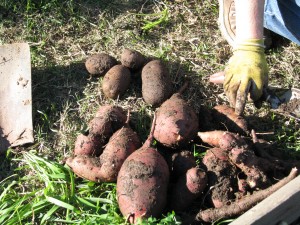
Beautiful yam harvest. I am in sensory heaven. Outside frost is again settling – a rarity here in Fallbrook, CA. Inside…. mmmm. My daughter is juicing today’s harvest of oranges. On the stove I’m poaching the last of the Harry and David pears my son sent before Christmas, in a bath of Julian apple cider (I’ve had frozen since October!), cinnamon and vanilla. There is a touch of woodsmoke from the wood burning stove. The mingled aroma of vanilla, orange and cinnamon in the air is incredible. In the fire are two homegrown potatoes in foil baking for dinner, and I’m cutting squares of homemade bread (it rained the other day… great baking and soup day!) to toast in the fire on fondue forks with mozzarella cheese and drizzled with Just Dip It (an olive oil, vinegar and herb blend from Temecula Olive Oil Co.). I am saturated with contentment and gratitude.
I wanted to write a blogpost for the first day of the year about gratitude. Instead I’m writing about harvesting yams and sweet potatoes, which, I believe, amounts to the same thing.

Tiny Russian Banana potatoes I grew in a nursery container Today the air was clean and almost 60 degrees F. Maxfield Parrish clouds filled the sky making it hard to pay attention to anything else. My daughter and I finally fired up Harry Mud, the cob oven. We experimented by baking small frozen pizzas, to success. Then in went homegrown, wrapped sweet potatoes, garlic and russet potatoes to slowly bake in the ashes. I hope I can convey sweetness of sitting outdoors on New Year’s Day eating pizza and smelling home grown potatoes and garlic cooking in a mud oven that we built, from mud from our property, as a snowy egret watched us carefully from the pond and our hens figured out how to beg. Peace. Enjoying the payoff of hard work. Eating health.
In the last few days we’ve dug up several patches of yams and sweet potatoes, the greenery of which had just been frosted black. I plant them all over the property to fill the groundcover niche of the plant guilds. I also grew some in my raised veggie beds. Some of the sweet potatoes had been small last year and so I left them in the ground. They grew.
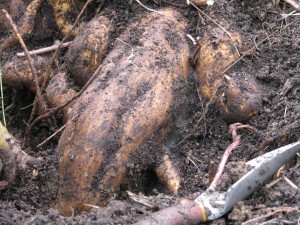
This enormous one was six pounds! The flavor of homegrown, organic potatoes is beyond description. You don’t need sugar and marshmallows dumped on the yams; potatoes aren’t just a vehicle for toppings. I steam them, eat them with butter, salt and pepper. Phenomenal. On Christmas I roasted wedges of yams with garlic and olive oil, and not only were they terrific, the leftovers I mixed into a hash for breakfast and it was sensational.
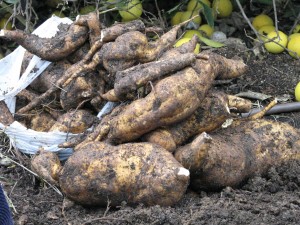
Freshly dug sweet potatoes Yams and sweet potatoes are what Americans call the orange or white tubers, respectively, sold in the grocery stores. There are actually hundreds of varieties of sweet potatoes of many colors and flavors. They are semi-tropical and like warmth. To grow, buy an organic sweet potato or yam and allow it to sprout on your counter. This is the easiest way. You may also buy slips from organic growers. Please, please don’t buy non-organic seed, slips or bulbs. Please don’t be Round-up Ready.

Colorful yams full of antioxidants. Take a sharp knife and cut slices from your sprouted yam, each containing at least one sprouted ‘eye’ , and lay them out to air dry for a couple of days in a cool, dry place out of direct sunlight. This hardens them off. Don’t plant a whole potato because the plant will have all the food it needs to produce greenery and won’t feel the need to make as many tubers. Plant the slips in well-drained soil that isn’t heavily manured; as long as water doesn’t sit around the roots, they will probably grow. I’ve had luck in many kinds of soil. The plants will spread out in a lovely, glossy-leaved groundcover that protects the soil and reduces weeds. Let the vines run and enjoy the small yam flower. Harvest in late fall, or when the greenery dies off.
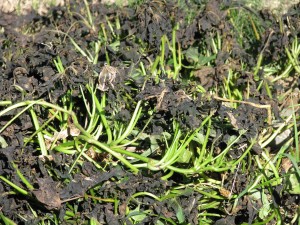
Frosted leaves of sweet potatoes Carefully dig and lift the potatoes. The skin will be more delicate than on yams store-bought. Lay the dirt-caked potatoes out to dry off before you store them in a cool dark place. Keep small slips and roots for replanting. The flavor of homegrown organic potatoes will make you wonder what the tasteless mushy things you’ve been eating have been.
This last year had its share of terrible losses, worry, pain and disappointment, along with great joy and contentment if I opened my eyes to them. They say that you reap what you sow, and as the garden and my experience deepens, and as my life mellows, I feel the truth in it. This morning we had fresh juice made of passionfruit, guava, oranges and pomegranates, all of which we grew. The potatoes, garlic, squash, greens, pickles, passionfruit curd, strawberry jam, dried tomatoes, all are at hand because of planning, sowing, nurturing, harvesting and preserving or storing. This may seem incongruous, but I am astonished at how many friends I have gained this year, through my volunteer work and exercise classes, in addition to those gained while working with County Parks, Sullivan Middle School, and the SDZoo Safari Park. So many that I wrote out the names and counted and marveled. Perhaps the list would be small for others; I don’t know, but it is wondrous and enough for me. At age 51, I have more friends and good acquaintances than I’ve ever had in my life. I am so grateful. I not only reap what I sow, but just as in my garden harvest, I have more than I could have imagined.
I do not follow a religion. In Buddhism it is said that life is a walking meditation; that every step you take is a prayer. As I put one foot in front of the other walking through the last part of my life, as I dig yams and eat them redolent with the health of good soil, as I watch those Maxfield Parrish clouds, as I laugh and work with friends who miraculously smile when they see me, I wordlessly pray my gratitude to the universe.
I very truly wish for you a year filled with gratitude and peace, and health-giving food that nourishes your heart and soul as well as your body.
- Animals, Books, Breads, Chickens, Compost, Gardening adventures, Giving, Health, Humor, Permaculture and Edible Forest Gardening Adventures, Pets, Recipes, Reptiles and Amphibians, Soil, Vegetables
The Life of Di, or Fall At My House
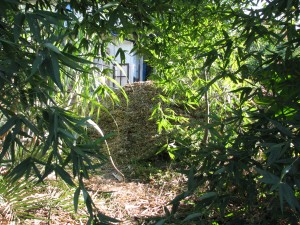
“And here’s another fine mess you’ve gotten me into!” I like to be involved with many projects at once. I picture my life as an opal, my birthstone, full of swirled colors and hues. I have several books going at once, projects chipped away at around the house, volunteer responsibilities strewn across my week, and far too many animals and acres to care for. When I’m exhausted I can spend a day on the couch reading with no trouble at all being the picture of laziness. Prior to Thanksgiving I underwent a skin cancer preventative treatment on my face and hands, which required applying a topical cream twice a day that brings suspicious cells to the surface and burns them off. By the end of the second week I was quite a mess, and then took another week to heal enough to be seen in public without alerting the zombie hunters. The treatment, needless to say, kept me from being in sunlight, therefore housebound. Always loving a clean, organized house but never actually completely cleaning or organizing, I figured I’d get some work done. I tried sorting about 15 boxes of photo albums left by my mother and grandmother… and got through one box before I had to stop. I wanted to bake bread, and I wanted to find something to do with the small amount of hops we harvested, so I experimented with a recipe that had a starter, sponge and rising that altogether took five days. The Turnipseed Sisters’ White Bread from the classic Bernard Clayton’s New Complete Book of Breads .

Turnipseed Sisters’ White Loaf starter made with hops. The starter really smelled like beer. Not in a pleasant way, either. However the bread was good, and baking was fun.

Good sandwich and toast bread. Just the extra carbs I needed for sitting on my butt for two weeks, right? Then I wanted to thin, clean and alphabetize the fiction section in my living room.

Books piled alphabetically… a little later there was a small avalanche. Yes, I have enough books in my house that they are in sections. Former school librarian and bookstore worker here. I haven’t done the non-fiction section as yet, which extends to most of the other rooms in the house. Maybe next year? I did a little writing, a lot of reading, surrounded by my elderly dog Sophie

Sophie enjoying good sleeps. who keeps returning from the brink of death to sleep about 23 hours a day, and one of my hens, Viola, who suddenly went lame in one leg.

Viola on a healing vacation. All advice was to cull her, but I thought that she pulled a muscle and hadn’t broken her leg, and being vegetarian I don’t eat my pets. Viola has been recuperating in a cage in the dining room, gaining strength in that leg, laying regular eggs, having full rein of the front yard, and crooning wonderfully. As I count wild birds for Cornell University’s Project Feederwatch, I keep an eye on the hen. The cats ignore her, thank goodness. I’ve quite enjoyed having a chicken in the house. Yep, I’m starting to be one of those kinds of aging ladies.
In between I’d spend time crawling under bushes to push and shove my 100-pound African spur thigh tortoise out of his hiding spot and into the heatlamp-warmed Rubbermaid house he shuns so that he wouldn’t catch cold in the chill damp nights. I always come out victorious, with him angry and begrudgingly warm, and with me wet, muddy, hair full of sticks and hands full of scratches. Does anyone have a life like this?
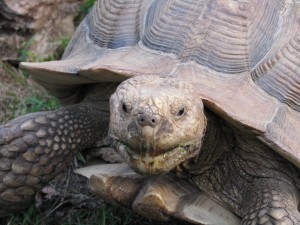
“I’m performing advanced trigonometry in my head, don’t bother me, Woman!” Finally my skin healed enough so that I was able to venture outdoors.
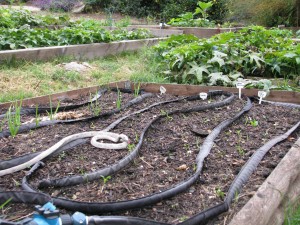
Garlic and seed sprouts guarded from birds by a rubber snake. I planted seeds of winter crops: collards, kale, garlic, onions, carrots, Brussels sprouts and broccoli rabe, and prepared raised beds for more.
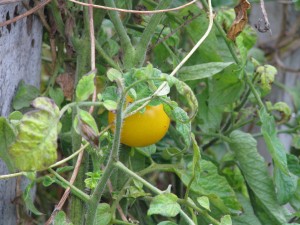
Yellow perfection tomatoes still ripening, as are the green zebra. I ordered organic pea, lupine and sweet pea seeds from Baker Creek Heirloom Seeds , all nitrogen-fixers to plant around the plant guilds.

Pepperoncini still producing. On Thanksgiving I hiked 1200 feet up Monserate Mountain in a record slow time; all that sitting and all that bread causing me to often stop and watch the slow holiday traffic on Hwy. 15, and be very glad that I was on a hike instead.
The neighbors had their annual tree butchering, paying exorbitant sums to have the same so-called landscapers come in and top their trees (shudder!) and thin others… for what reason I have no idea. Because being retired Orange County professionals they believe that trees need to be hacked back, contorted, and ruined? Possibly.
Please, please, please, friends don’t let friends top trees! Find an arborist who trims trees with an eye to their health and long-term growth and immediate beauty. A well-pruned tree is lovely, even just after pruning. A topped tree is brutal and ugly.

A topped coral tree. Ugh! Anyway, the upside is that I claimed all the chips, giving new life to the ravaged trees as mulch for my pathways. Two truckloads were delivered. I think I have enough for the whole property.
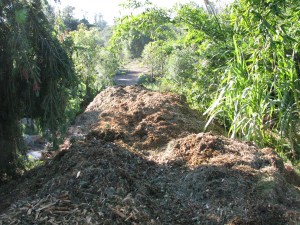
“The bear went over the mountain to see what he could see. He saw another mountain…” How to spread it? Yep, one wheelbarrow full at a time.
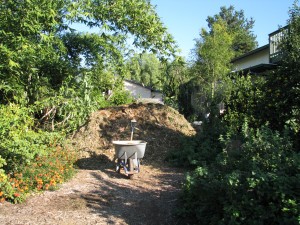
One wheelbarrow at a time. I can now condition myself for more hiking and weight lifting without leaving the property. The heaps have a lot of pine in them (they thinned the pine trees!???) so there is a pleasant Christmassy smell emanating from the heaps.
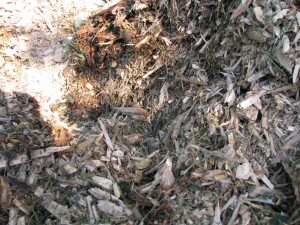
Hot steamy mulch. They are also very high nitrogen and were hot in the center on the second day and this morning were steaming right after our brief rain shower. Mulch piles can catch fire; when I worked for San Diego County Parks we rangers would joke about who had been called out by the fire department when their newly delivered mulch pile had caught fire in the night.
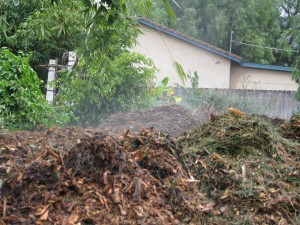
Steam from the mulch mountains. I stood on it just now and steam went up my pant legs and warmed me up! I also received a gift of seven 15-gallon nursery containers of llama poo!

The wealth of llama poo. Hot diggity! Early Christmas: My diamonds are round and brown, thank-you. I layered them in the compost heap and am ready for more.
I also wholeheartedly participated in Small Business Saturday, finding happy locals and crossing paths with friends and aquaintences at several stores. I received my first Merry Christmas from a man at Myrtle Creek Nursery’s parking lot as he waited for his son’s family to pick out a Christmas tree. I do love this town.
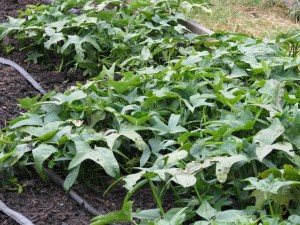
Sweet potatoes ready to harvest for Christmas dinner. That catches me up. Lots of projects, lots of volunteering, lots of cleaning up to do before my daughter comes home for the holidays and despairs at my bachelorette living. Lots of mulch to move. Lots of really great friends. Lots of sunscreen to wear. Lots to be thankful for.
-
Preserving Squash and a Terrific Pumpkin Chai Recipe!

Beautiful patterns on the banana squash shell. Four sugar baby pumpkins that I’d kept for myself, and three pink banana squash, were all in need of preservation. They were not keeping well due to the warmth of our hot San Diego county Fall. During a rainy break in the weather I did something about it. You can preserve cooked pumpkin and winter squash best by freezing it. If you have a pressure canner you may can pureed pumpkin or pumpkin pieces in liquid, but since I only use the water bath method that wasn’t an option.

Even sugar baby pumpkins can be difficult to cut when raw. There’s a better way! Roasting a squash isn’t difficult at all. In fact, you only have to wash it, put it on a tray in a 350F oven for about an hour (longer if its a really large pumpkin), and then slice when cooled.

Roasting a whole pumpkin makes the scooping so easy! Its easy to scrape out the seeds and then spoon out the cooked flesh out of the hardened shell. This is what I did for the sugar baby pumpkins. There was too much banana squash to fit whole into the oven, however, so I cut them into chunks, scooped out the seeds, covered them with aluminum foil (it helps steam them) and baked 350F for forty-five minutes.
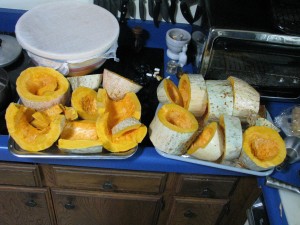
Three banana squash is a lot of squash I have more details here. I also roasted the pumpkin seeds.
Then I had a lot of squash to puree! These squash and pumpkins were dry, so I added a little water to the VitaMix and tossed in the chunks.
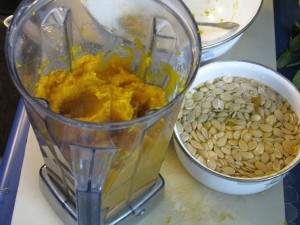
Pumpkin and seeds. I pureed batches until smooth, then spooned cups full into freezer bags. My pumpkin scone recipe calls for only half a cup, so I froze one-cup batches, as well as two-cup batches for pie. The secret to ‘vacuum-packing’ freezer bags is to close the top of the bag around a straw and then suck all the air out. It really works well, and is kind of fun, too.

Get a straw, suck out the air and presto: vacuum packed! However, the best thing that happened out of all this squashing was that I had a little less than a cup of pureed roasted squash left in the VitaMix, too little to freeze and really irritating to scoop out. It was a cold day and past lunchtime. I had an idea and spooned in what was left of some Chai tea mix, poured in vanilla soy milk, blended it until it warmed up and sat down to drink. Heaven! I’m not one for pumpkin flavored things, but this was the real deal.
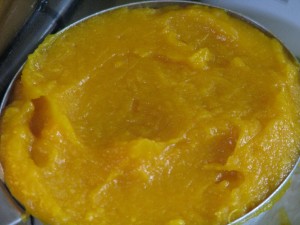
Pumpkin puree. It was so good that the next day I took a cup of the pureed squash that I refrigerated, poured in 1 1/2 cups of vanilla soy milk, a touch of orange syrup left over from candying orange peel, added cinnamon and blended until it was hot. It was thick, satisfying, a little sweet, spicy and full of beta carotene, fiber, protein and other good things. I’m sure you can do the same thing with canned pumpkin and other liquids, such as milk, rice milk, almond milk or coconut milk. If fact, I insist that you try it.

Hot Yum! Pumpkin ChaiAuthor: Diane C. KennedyRecipe type: BeverageCuisine: AmericanPrep time:Cook time:Total time:Serves: 2Cold or hot, spiced pureed pumpkin or squash mixed with the milk of your choice is extreme comfort food that is actually terrific for you!Ingredients- 1 cup cooked pumpkin or squash puree, fresh or canned.
- 1½ - 2 cups vanilla soy milk, or milk of your choice. (Less for a thick drink).
- ½ - ¾ teaspoon cinnamon, pumpkin pie spice or up to 1 scoop Chai tea mix.
- Sweetener (optional); a natural syrup would do or honey.
- ½ teaspoon vanilla (optional)
Instructions- For cold pumpkin chai mix all ingredients briefly in a blender or VitaMix.
- Taste to adjust seasonings, thickness and sweetener, and serve.
- For hot pumpkin chai, heat milk and add to the rest of the ingredients in a blender and process. If you have a VitaMix, you can add all cold ingredients and then process until it is hot.
I’m going to make some more for me right now. -
When Is Tuna Fish Not Tuna Fish?
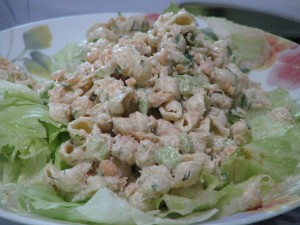
No-kill “tuna” salad! Prior to being a vegetarian, many years ago, I did enjoy a tuna sandwich or salad now and then. A perfect dish for a hot afternoon. During my almost twenty years of vegetarianism I’ve sampled many tuna substitutes, with various results. Most of them were discontinued, or were imported to a store on the East coast and then resold and shipped. Have you ever noticed how foods that are marketed as substitutes for other foods either have quotations around their names as if someone was whispering it behind their hand? Or else the names are spelled wrong, like Tuno or Bakon. There is also the saner although still questionable method of placing the word ‘mock’ in front of the word, such as ‘mock-tuna’, which is better than misspelling. Anyway, back to the topic, in trying to keep my carbon footprint low I’m eliminating the purchase of goods that require so much shipping.
This week I discovered a marvelous tuna substitute (I say, “discovered” when really I’m probably the last to know). It is low calorie, high in protein and fiber, inexpensive, easy to prepare, doesn’t kill tuna or dolphins, and they grow here in California. I can also buy them organic. They are garbanzo beans, otherwise known as chickpeas.
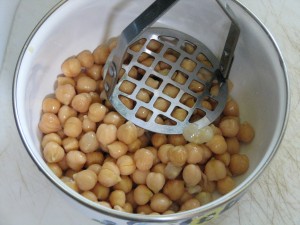
Mash garbanzos (what a great name for a bean!) until they are almost smooth. The flavor of garbanzo beans is very mild and takes well to light seasoning. Substitute mashed garbanzo beans in your favorite tuna salad or sandwich recipe. If you use Veganase – a dairy-free mayonnaise substitute – then you have a mock tuna salad or sandwich that won’t be dangerous to eat at picnics because neither the beans nor Veganase spoil quickly. Incorporating dill into the mix gives the mix a fishier flavor, since dill is so commonly paired with fish. Simple, nutritious, inexpensive and very yummy. Can’t go wrong with that!
Mock Tuna SaladAuthor: Diane C. KennedyRecipe type: EntreePrep time:Total time:Serves: 2-4A high-protein and fiber, low-cost tasty tuna substitute without any trace of mercury or dolphin!Ingredients- One can organic garbanzo beans
- 2-3 tablespoons Veganase or mayonnaise
- 1 teaspoon minced dill, preferably fresh
- 2 stalks celery, chopped
- 2 -3 cups cooked, cooled small shaped pasta, such as shells
- ¼ teaspoon ground cumin
- Salt and pepper to taste
- Chilled iceberg lettuce
Instructions- Drain and empty canned garbanzos into a small bowl.
- Mash with a potato masher until almost smooth, keeping some of the lumps for texture.
- Stir in Veganase, dill, celery, cumin, salt and pepper.
- Stir chickpea mixture into cooled noodles until well mixed.
- Serve over iceberg lettuce with a dill pickle on the side.
-
Two Sure-fire Zucchini Recipes
Zucchini plants are like cats: They both look harmless when small, so you think the more the merrier. One plant is always enough, but it is hard to plant just one seed in case it doesn’t come up. Then the sprouts are hard to thin.. what if something eats it? Then before you know it, there are five enormous plants growing giant green clubs in the dead of night, just after you’ve checked all the plants. Well, that’s my situation anyway. Too many cats; too many zucchinis. When there are enough all at one time, we’re taking them (the zucchinis, not the cats) to the Fallbrook Food Pantry along with pumpkins and tomatoes. Until then, we’re exploring new ways to eat them. And I refuse to sully cheesecake with zucchini! (yes, there is such a recipe!).
My son who is studying Culinary Arts at the University of Hawaii sent me a link to smittenkitchen.com with an exceptional zucchini pancake recipe… not sweet, very light and completely tasty. I’ll include my version. But first I want to explain my ‘discovery’, which everyone but me probably knows about anyway.
SAUTEED ZUCCHINI
I had grated zucchini for bread and had some left over. It was dinnertime and I was alone, so I experimented. I heated a skillet with a little olive oil in it, threw in the grated, undrained zucchini, and stirred it around on medium-high heat for about five minutes. When it was beginning to wilt and brown a little on the bottom, I sprinkled sesame oil on it lightly, and then gave it a touch of Bragg’s Amino Acids, which I use for many things. A light soy sauce may substitute, but Bragg’s is high in nutrition, low in salt and a wonderful flavoring. Buy it online or in health food stores. The zucchini came out tasty and with a mouth-feel of wet wide noodles. It was fantastic. I’ve since made it for my daughter a couple of times, and each time we wanted more! Imagine that! On the plus side, it used up a medium zucchini.
You really must give these pancakes a try.
Fabulous Zucchini PancakesAuthor: Diane C. Kennedy (adapted from smittenkitchen.com)Recipe type: BreakfastPrep time:Cook time:Total time:Serves: 4A light, flavorful, really good pancake that uses up a lot of zucchini and tastes like zucchini bread.Ingredients- 2 large eggs
- 3 tablespoons olive oil
- 2 tablespoons sugar (optional)
- ¼ cup buttermilk or soured milk
- ½ teaspoon vanilla extract
- 2 cups shredded zucchini
- 1 cup all-purpose flour
- ¼ teaspoon table salt
- 1 teaspoon baking soda
- 1 teaspoon ground cinnamon
- ⅛ teaspoon ground or freshly grated nutmeg
- ¼ cup semi-sweet chocolate chips (optional)
- Oil, for coating skillet
Instructions- In a large bowl whisk eggs, olive oil, sugar, buttermilk and vanilla until smooth.
- Stir in zucchini.
- In a smaller bowl, combine flour, salt, baking soda, cinnamon and nutmeg.
- Stir dry ingredients into zucchini batter, mixing until just combined.
- Stir in chocolate chips.
- Heat oil or butter in a large, heavy skillet over medium heat.
- Scoop ¼-cup rounds of batter in pan so they do not touch.
- Cook until bubbles appear on the surface, about 2 to 3 minutes.
- Flip pancakes and cook another minute or two.
- Keep pancakes warm in on a tray in the oven set on low or in a toaster oven.
- Repeat with remaining batter.
- Serve warm with or without traditional pancake toppings.
- Pancakes freeze well.
- Gardening adventures, Heirloom Plants, Permaculture and Edible Forest Gardening Adventures, Vegetables, Vegetarian
Fun Vegetables

A small green zebra, not quite ripe In a past post I related how my mother had witnessed a woman staring hands-on-hips at the produce selection in a grocery store and exclaiming, “I wish they’d come up with some new vegetables!” How true is that? How many ways can you cook the limited offerings in your average supermarket produce section without going out of your mind? That’s where a trip to an ethnic grocery store can be a life-saver. Or, plant some fun new varieties in your garden.
Thanks to Baker Creek Heirloom (Organic) Seeds and their fantastic catalog, I was spoiled for choice. I also buy a lot from Botanical Interests , an organic seed company which has packets for sale in stores such as my neighborhood Joe’s Hardware. Their wildflower seed mixtures are highlights of my garden and attract birds, butterflies and other insects. Here are some newbies I tried this year, and the keepers:
Zucchino Rampicante : an heirloom zucchini that grows on a vine. This squash grows curled or straight on long vines that need support. The fresh squash can be used like zucchini, but are firmer and have a mild butternut flavor that goes well with everything. I am completely in love with the taste of these.
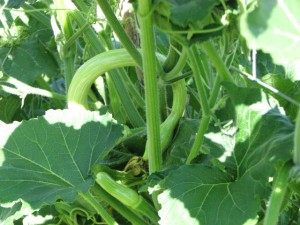
Some zucchinos are straight, some follow their own tune PLUS: if you leave the squash on the vine, it grows huge and unlike those monsterous zucchini clubs that are practically inedible and unwanted, zucchino then hardens and you can store it and use it as a winter squash! How marvelous and unwasteful is that! Zucchini without the pressure. No more alienating your neighbors and friends with excess squash.
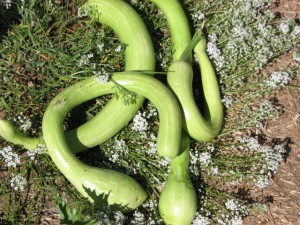
Zucchino shapes are marvelous Green Zebra Tomato :a large, lime-green striped tomato that develops a slight yellowish tinge between the stripes when ripe. These gorgeous tomatoes are rich and slightly tart, but without heavy acid. Marvelous on a open-faced sandwich or in a caprese salad to show off the color inside.
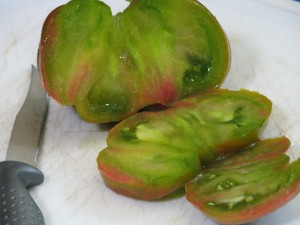
Green Zebra: beautiful inside Thai #2 Red Seeded Long Bean: The seeds were given to me by the woman who introduced me to Baker Creek Seeds, and who built my chicken and quail coops. I planted the seeds by stakes that turned out to be too short for the vines.
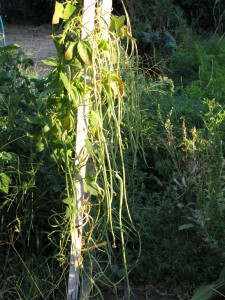
Long beans growing very long. However, these beautiful flowers eventually came, followed by spectacularly long thin green beans two feet long! One bean per person! (Just about, anyway). They are good stir-fried. I haven’t tried to tempura one yet, but its tempting.

Six long beans slice up to a serving for two! Mortgage Lifter Tomato : Now THESE are the ultimate sandwich tomato. These heavy pink-red fruits have mostly meaty insides and have an incredible savory flavor. I have found my favorite red tomato. Beefstake has nothing on this baby. It also has a cool name.
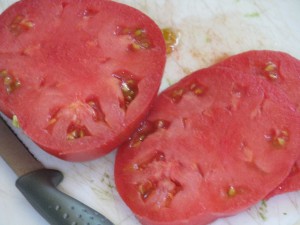
Mortgage Lifter is very meaty and savory 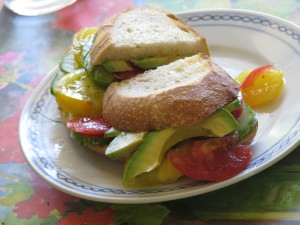
Rice Blue Bonnet: the jury is still out on this one. This is a dry-land rice. I didn’t thin it when I should have, so it is growing in clumps and hasn’t progressed beyond the thin leaves. My fault. It is growing and would probably be successful if I handle it right.
Basil Custom Blend HEIRLOOM Seeds : I planted a row and have regular and purple basil, lime basil, and cinnamon basil (one of my favorite scents). Today I used the regular and purple chopped over an open-faced tomato sandwich, and my daughter added leaves from the other two to a fruit salad.
Sesame, Light Seeded : Beautifully flowered plants with seed pods full of sesame seeds! How great is that?
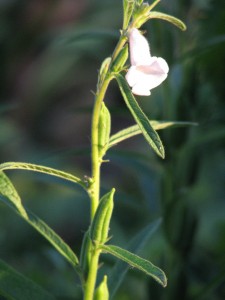
Sesame pods. Broad Windsor Fava Bean : I planted a lot of legumes to help build the soil (they set nitrogen), and tried fava beans this year. They grow like crazy, take a lot of neglect, and produce a fantastic protein source in the form of a tasty bean. They are a little trouble to shell, but well worth it. I wrote about favas here.
Blue Potatoes: These I started several years ago from an organic blue potato I bought at a grocery store. Since there are usually some small tubers left in the soil, I have volunteers sprouting every year. These blue potatoes – whatever their true variety is – are a lovely purplish blue outside, with a lovely purple center as well. They aren’t starchy, but are best used like red potatoes. Very fun.
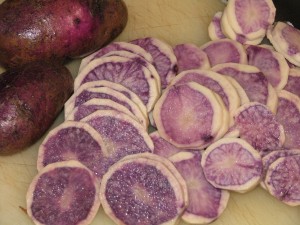
Peeled purple potatoes - Animals, Chickens, Gardening adventures, Heirloom Plants, Herbs, Other Insects, Permaculture and Edible Forest Gardening Adventures, Photos, Ponds, Quail, Vegetables
What’s Happening in the July Garden
A banana squash stealthily growing huge An apricot tree with fava beans, squash, herbs, artichokes, and tomatoes The withy hide growing beautifully Kabocha and delicata squash on the ground, zucchino rampicante on the trellis, Christmas beans, favas, Swiss chard and medicinal plants around a small avocado tree Favas: great for the soil, great for the dinnerplate Heirloom tomatoes. Why do they all come ripe at the same time? Sugar pumpkins are ripe already in the Mediterranean guild. Also figs, paste tomato, dill, fennel, thyme, pickling cucumbers and artichoke. Plant guilds of squash, beans, flowers, etc. are flourishing. Heirloom green melons hiding from the hot sun. By now the wild buckwheat has dried up, which starves the bees. But not here. Matilija and Flanders poppies over banana squash Monarchs are so plentiful this year that we have to take pains to avoid them. Wildflowers host an incredible diversity of insects Dill flowers looking like a spectacular firework In a balanced wildlife habitat, bunnys do little harm All five girls waiting for treats in the Fowl Fortress Pumpkins, bananas, bamboo and much more by fescue paths. Fresh grape leaves, dill and garlic from the garden for the pickles Hot weather? Must be canning season! Pickled cucumbers, zucchino and onions, and peach pit and peel jelly. Very large yellow waterlilies Native salt heliotrope by the big pond. Volunteer tomato in the shade of the Nest, by palm tree bench. Wisteria, grapes and zerpheranthum lilies around the Nest Blooming banana Quail eggs! Double heirloom hollyhock Egyptian lilies Fourth of July rose celebrating the holiday
